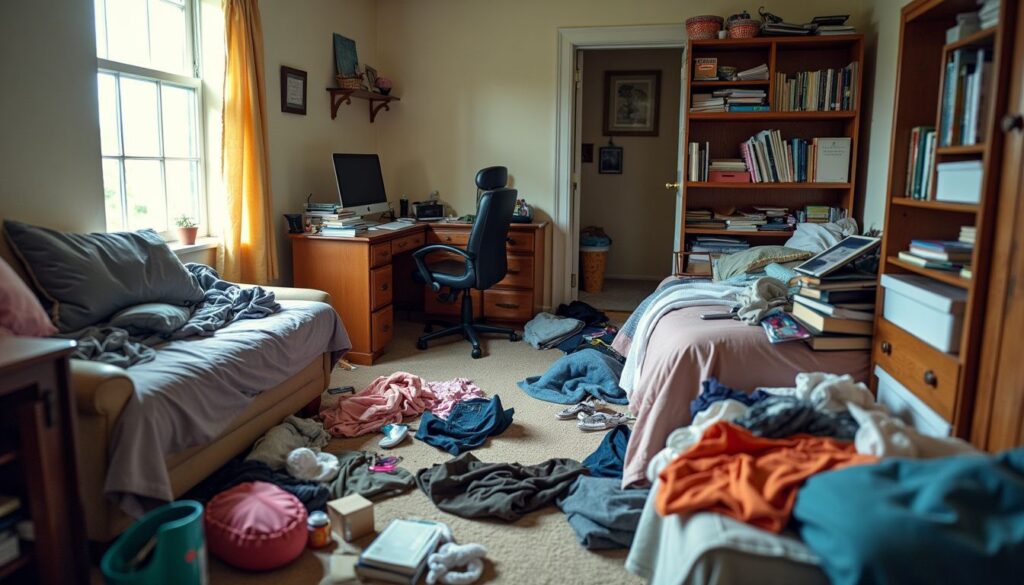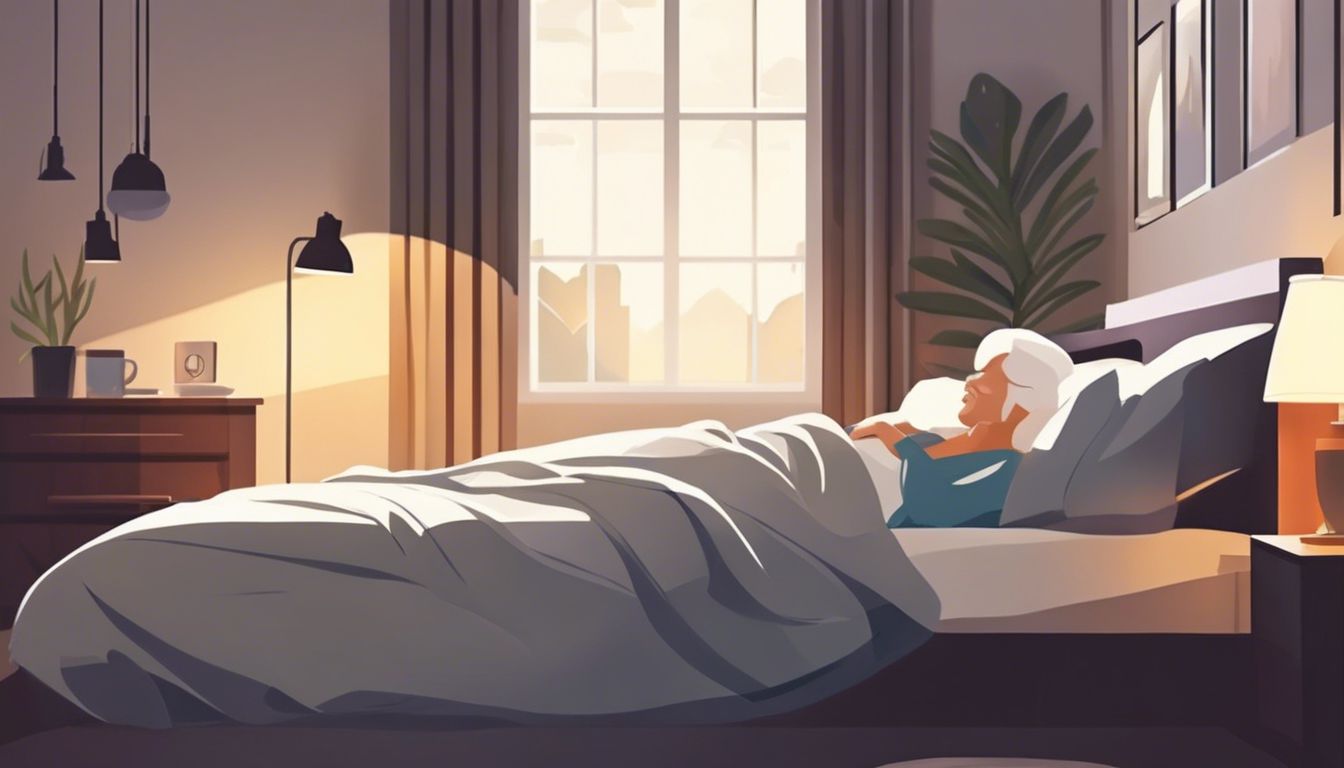Clearing clutter from a caregiver’s bedroom is hard but necessary. A messy space can harm your mental well-being. This article gives you easy steps to create a tidy, stress-free room.
Start reading now!
Key Takeaways
- Start decluttering by setting clear goals and cleaning a little every day.
- Use bins, labels, and shelves to keep important items organized and easy to find.
- Make the bedroom safe and easy to move around in with accessible furniture and safety features.
- Keep up with daily cleaning tasks for a healthier environment.
- Donate or sell things you don’t need anymore to keep clutter under control.
Setting Your Decluttering Goals

First, find the main spots in the bedroom that need work. Then, choose doable deadlines to finish cleaning tasks.
https://www.youtube.com/watch?v=h2EqqcdsLck
Identify priority areas in the bedroom
Look for places that get messy fast. Start with the floor and work your way up. Clothes, medical supplies, and daily use items often make the biggest messes. Putting these things away makes a big difference.
Next, check surfaces like nightstands and dressers. These spots collect clutter from everyday life—things like cups, books, and personal care items.
Decluttering is not just cleaning; it’s creating a better space for you.
Next up: setting realistic timelines for decluttering tasks keeps everything manageable.
Set realistic timelines for decluttering tasks
Caregivers should plan to spend 30 minutes each day on cleaning tasks. This makes it easier to manage without feeling overwhelmed. Start with small spots in the bedroom and set a goal to clear one area at a time.
For example, focus on dusting off the nightstand on Monday, then move to vacuuming under the hospital bed on Tuesday.
Using items like labels helps keep everything in its place once you organize. Make sure medical supplies have their own storage so they are easy to find. Stick to this routine every day.
Soon, keeping the bedroom tidy will become a habit that improves both your mental health and your environment.
Essential Decluttering Steps
Tackling the mess in a caregiver’s bedroom starts with sorting and clearing out. Use bins, shelves, and labels to keep everything in its place.
Remove all trash and unnecessary items
Start by compiling all the unwanted items in the bedroom. This includes old documents, used tissues, and any discarded wrappers. Utilize a trash bag to assemble everything. Ensure you also inspect beneath the furniture and in corners where refuse often accumulates.
Next, evaluate objects that are unused or disregarded. Organize them into classifications: retain, give away, auction or discard. For those caring for others, this could require organizing through outdated medical supplies or redundant equipment.
A vacuum cleaner can assist in tidying any residual dust or minute debris post-organizing. Commit to 30 minutes daily on these chores for optimal results.
Organize essentials for easy access
Keep daily needs within arm’s reach. Use nightstands and dressers for things you grab often, like remotes, glasses, and medicine. Put medical supplies in a clear bin on a shelf. Label the bins with big, easy-to-read words.
This way, you find what you need fast.
Make room for cleaning tools under the bed or in a closet corner. Keep your mop, vacuum cleaner, and dust cloths together so cleaning is quicker. Follow the “one in, one out” rule to stop clutter from coming back.
If you get new dinnerware or electronics for the bedroom, give away something else. This keeps stuff under control and makes sure there’s space for important items without searching through piles of things you don’t use anymore.
Implement storage solutions for medical supplies
Once essentials are in place, focus on medical supplies. Use clear bins and labels for quick finds. This makes it easy to grab what’s needed without searching. For safety, keep meds locked up but within reach.
Sort items by use: daily, weekly, emergency. This setup saves time and stress.
Shelves near the bed or chair help too. Put often-used items here—like bandages or a thermometer. For bigger things like a blood pressure monitor, dedicate a cabinet space nearby.
Make sure everything has a spot and return it after use. This keeps the room tidy and supplies ready for when they’re needed most.
Maintaining a Clutter-Free Space
Keeping a caregiver’s bedroom tidy is key. Regular cleaning and the “one item in, one out” rule help a lot.
Schedule regular cleaning sessions
Make cleaning a daily habit. Spend 30 minutes each day to keep things tidy. This makes sure the bedroom stays clean and is easier to manage. You can use a vacuum cleaner for curtains, rugs, carpets, and floors.
For floors that are hard, mop them with a cleaner that kills germs.
A clean room is a healthy room.
Also, change sheets often. If someone is always in bed, change their sheets every other day. This keeps the bedroom fresh and safe for both the caregiver and the person they care for.
Adopt the “one in, one out” rule
After cleaning regularly, using the “one in, one out” rule keeps things simple. This means if you get a new item for the bedroom, you remove an old one. It stops too much stuff from filling up the space.
For example, if a caregiver gets a new vacuum cleaner to keep the room clean, they should find an older item to donate or throw away.
This method also helps with making decisions on what stays and goes. If there’s no more room for something new without removing something else, it makes you think about what items are really needed.
Caregivers can use this rule for clothes, medical supplies, or any other items in their bedroom to make sure everything has its place and is easy to find when needed.
Use labels for organization
Labels make everything easier to find. They help you keep track of what goes where. For example, put labels on bins for medical supplies, clothes, and personal items. This means less time searching when you need something fast.
Putting labels on shelves helps too. You can mark spots for dishes or vacuum cleaners. This helps keep the room neat and safe for everyone. It also makes it easy to know what needs a refill or replacement without looking through everything.
Special Considerations for Caregivers
Caregivers need rooms that are safe and easy to move around in. Keep this mind for a better space. Read more for simple changes that can make a big difference.
Accessibility and safety features
Make the bedroom easy to move around in. Use beds like Transfer Master’s home hospital ones. They adjust with power and have covers that are simple to clean. This makes caring for others safer and easier.
Add grab bars near the bed and in the bathroom. Put a night light in so they can see at night. Change sheets often, every week or more if needed, but don’t worry about flipping mattresses; modern ones don’t need it.
A neat space is a safe space.
Keeping emotional well-being in mind
Caregivers need a peaceful bedroom for good mental health. Decluttering helps them feel better and less stressed. Spending 30 minutes every day cleaning makes a big difference. It’s important to keep things simple for them.
A clutter-free space also means easy access to what they need, like medical supplies. This makes their work easier and safer. Planning goals for decluttering can improve their overall well-being too.
Utilizing Decluttering Tools and Resources
Find the right tools and places to help you declutter. There are shelves, boxes, and apps that can make organizing easier. Look for special furniture online or at stores that saves space.
Donate items you don’t need to charity shops or sell them. This way, your caregiver’s bedroom stays tidy and calm—perfect for rest and care. Keep exploring for more ideas!
Recommended products for organization
For caregivers, keeping bedrooms tidy is key. Check out shelves from The Caregiver Cafe’s e-commerce store. They’re perfect for stacking medical supplies. Use bins to sort items you use daily.
Label everything clearly—this saves time and stress.
Transfer Master beds offer easy-clean covers, making them a smart choice. Their powered adjustments help with patient care too. For donations or old furniture removal, local charities often pick up for free.
Make sure to call ahead.
Where to buy caregiver bedroom furniture
You can buy caregiver bedroom furniture at The Caregiver Cafe’s e-commerce store. They sell beds from Transfer Master. These beds have powered adjustments and easy-clean covers. Transfer Master has made these beds since 1993.
The Caregiver Cafe shop offers everything a caregiver needs for the bedroom.
For extra help, you can join The Caregiver Cafe Weekly Newsletter. It gives support to caregivers like you.
Where to donate or dispose of unwanted items
Find local charities and second-hand stores for items you can donate. They take clothes, books, and furniture. This helps others and keeps your home clean. For medical supplies, look into groups that accept these donations to help those in need.
For trash, use community waste services. Many have special programs for electronics and hazardous materials. Make sure to follow their rules so you do it right. This keeps your house safe from clutter and helps the environment too.
Conclusion
Transforming a caregiver’s bedroom into a well-organized space is essential. Begin by establishing straightforward objectives. Address one diminutive zone on a daily basis. Utilize containers and racks for medical necessities.
Make sure the space is secure and easy to traverse. Adhere to the principle of “one item enters, one item leaves” to deter fresh disarray. Maintain cleanliness with the assistance of relatives or guidance from a proficient organizer.
This ensures the happiness and safety of both the caregiver and the individual receiving care. A smartly organized area uplifts the mood and boosts productivity all day.
For a wide selection of caregiver-friendly bedroom furniture that combines functionality with comfort, visit our recommended furniture store.
FAQs
1. What is the “one in, one out rule” for decluttering a caregiver’s bedroom?
The “one in, one out rule” simply means when a new item enters the room, an old one must leave. This helps maintain order and prevent clutter.
2. How can privacy be maintained while decluttering?
Privacy can be preserved by respecting personal spaces and items like PCs or keyboards that may contain private information or electronic communications. Always ask permission before handling such items.
3. Are there any tips for dealing with emotional attachments to items during decluttering?
Yes! Understand that as a family caregiver, you might have sentimental connections to certain objects. It’s okay to keep some things but remember – space is important too.
4. Can I use the internet for help with decluttering?
Absolutely! The internet is a vast network full of helpful ideas and advice on how to effectively declutter rooms including bedrooms of caregivers.









